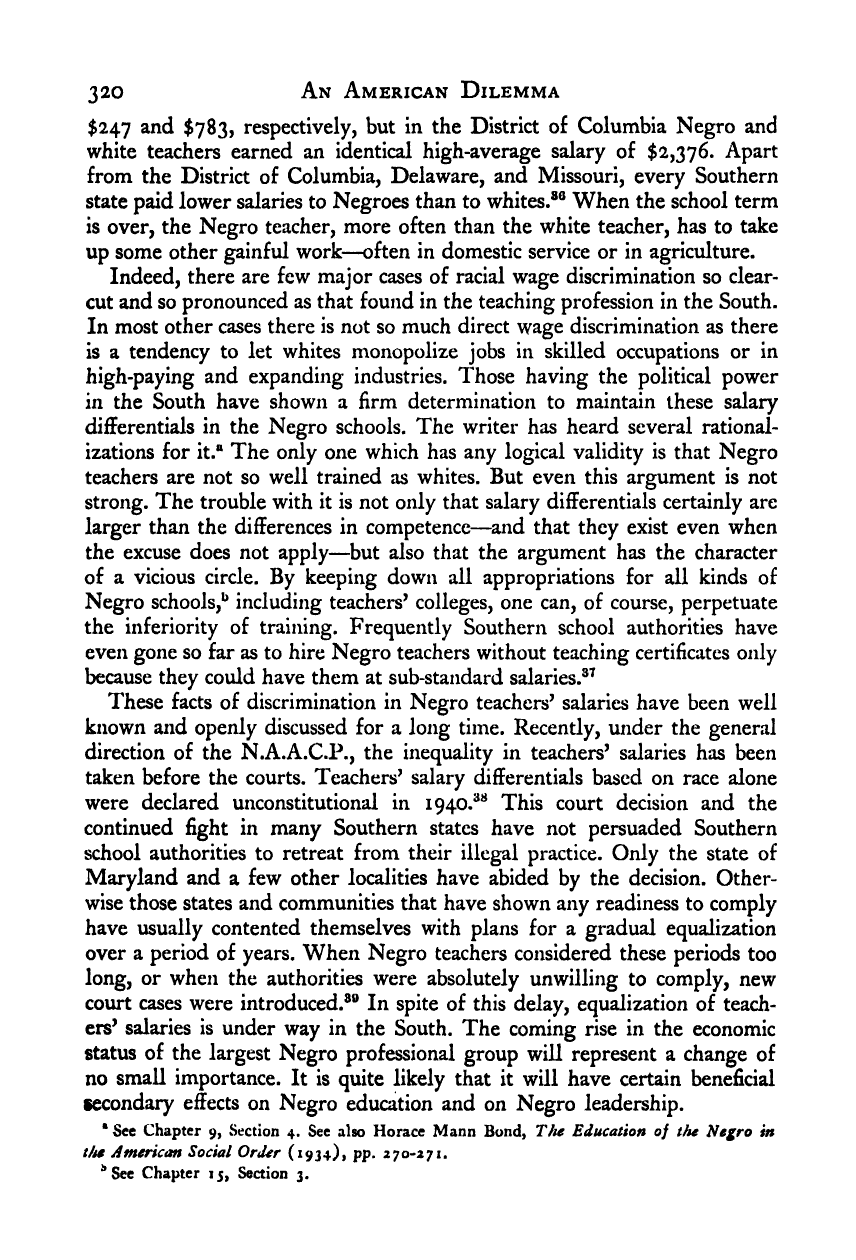Note: Gunnar Myrdal died in 1987, less than 70 years ago. Therefore, this work is protected by copyright, restricting your legal rights to reproduce it. However, you are welcome to view it on screen, as you do now. Read more about copyright.
Full resolution (TIFF) - On this page / på denna sida - IV. Economics - 14. The Negro in Business, the Professions, Public Service and Other White Collar Occupations - 4. The Negro Teacher

<< prev. page << föreg. sida << >> nästa sida >> next page >>
Below is the raw OCR text
from the above scanned image.
Do you see an error? Proofread the page now!
Här nedan syns maskintolkade texten från faksimilbilden ovan.
Ser du något fel? Korrekturläs sidan nu!
This page has never been proofread. / Denna sida har aldrig korrekturlästs.
320 An American Dilemma
$247 and $783, respectively, but in the District of Columbia Negro and
white teachers earned an identical high-average salary of $2,376. Apart
from the District of Columbia, Delaware, and Missouri, every Southern
state paid lower salaries to Negroes than to whites.*® When the school term
is over, the Negro teacher, more often than the white teacher, has to take
up some other gainful work—often in domestic service or in agriculture.
Indeed, there are few major cases of racial wage discrimination so clear-
cut and so pronounced as that found in the teaching profession in the South.
In most other cases there is not so much direct wage discrimination as there
is a tendency to let whites monopolize jobs in skilled occupations or in
high-paying and expanding industries. Those having the political power
in the South have shown a firm determination to maintain these salary
differentials in the Negro schools. The writer has heard several rational-
izations for it.® The only one which has any logical validity is that Negro
teachers are not so well trained as whites. But even this argument is not
strong. The trouble with it is not only that salary differentials certainly are
larger than the differences in competence—and that they exist even when
the excuse does not apply—but also that the argument has the character
of a vicious circle. By keeping down all appropriations for all kinds of
Negro schools,*^ including teachers^ colleges, one can, of course, perpetuate
the inferiority of training. Frequently Southern school authorities have
even gone so far as to hire Negro teachers without teaching certificates only
because they could have them at sub-standard salaries.*^
These facts of discrimination in Negro teachers’ salaries have been well
known and openly discussed for a long time. Recently, under the general
direction of the N.A.A.C.P., the inequality in teachers’ salaries has been
taken before the courts. Teachers’ salary differentials based on race alone
were declared unconstitutional in 1940.*^ This court decision and the
continued fight in many Southern states have not persuaded Southern
school authorities to retreat from their illegal practice. Only the state of
Maryland and a few other localities have abided by the decision. Other-
wise those states and communities that have shown any readiness to comply
have usually contented themselves with plans for a gradual equalization
over a period of years. When Negro teachers considered these periods too
long, or when the authorities were absolutely unwilling to comply, new
court cases were introduced.*® In spite of this delay, equalization of teach-
ers’ salaries is under way in the South. The coming rise in the economic
status of the largest Negro professional group will represent a change of
no small importance. It is quite likely that it will have certain beneficial
secondary effects on Negro education and on Negro leadership.
‘See Chapter 9, Section 4. See also Horace Mann Bond, Tfie Education of the Negro in
tfte American Social Order (1934), pp. 270-271.
^ See Chapter 15, Section 3.
<< prev. page << föreg. sida << >> nästa sida >> next page >>